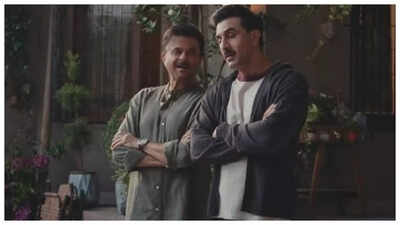That question — nature versus nurture — has hounded criminologists, psychologists and the screenwriter behind every serial killer movie ever made. With the latest season of its true crime anthology series, “Monster,” Netflix is jumping into the conversation by focusing on perhaps the most influential killer you’ve never heard of: Ed Gein.
Who is Ed Gein, and why is he getting the Netflix treatment?
Known as the Plainfield Ghoul, Gein (played by Charlie Hunnam in “Monster”) haunted rural Wisconsin during the 1950s and is confirmed to have killed two women. Two killings may not technically label him as a serial killer — but he was also a suspect in other unsolved cases.
However, it’s the gruesome details around those killings that went on to inspire the likes of “Psycho” and “The Texas Chainsaw Massacre.” After Gein was arrested, authorities entered his farm and found a house of nightmares: lampshades and masks made from human faces, a victim decapitated and disemboweled like a deer and, most infamously, a “woman suit” made out of skin peeled off corpses.
“I don’t think there’s anything else that comes close,” says James Alan Foxa research professor of criminology at Northeastern University. “There are a lot of other cases that are bizarre in one dimension or another, but this had the whole smorgasbord.”
Fox opens his book “Extreme Killings” with Gein’s case for a reason. It has murder, grave robbing and an all-consuming and abusive relationship between mother and son.
Growing up on a farm in Plainfield, Wisconsin, Gein was isolated from the outside world. His father beat him during alcohol-fueled bouts. His mother, meanwhile, rained biblical fire and brimstone down on him with daily sermons about the world’s immorality and why women were Satan’s temptresses.
Gein formed a doting yet abusive bond with the most powerful force in his life. Upon her death in 1945, Gein turned the farmhouse into a museum for his mother. He boarded up every room she had spent time in and left them pristine, even as he lived in squalor in the rest of the house.

“He seemed like a reclusive … man, harmless,” Fox says. “That sort of gets at the idea, which is true, that serial killers don’t stand out in a crowd. Most of the time you would hardly suspect them.”
Authorities would later come to understand just how far Gein went to make sure his mother’s memory stayed alive.
After authorities arrested Gein in connection with the disappearance of local hardware store owner Bernice Worden, they found Worden decapitated and disemboweled like a deer on Gein’s property. Inside the house, authorities discovered bowls made out of skulls, masks made from skin peeled off human faces, a skull and “face mask” later confirmed to be from local tavern owner Mary Hogan, Worden’s heart in a plastic bag, a belt made from nipples and the component parts of a “woman suit,” including leggings and a corset made of skin designed to help him literally inhabit his mother’s body. It was the result of Gein’s late night graverobbing.

Despite the gruesome details of Gein’s story, Fox says he’s been surprised by how many people know more about the Hollywood myths Gein spawned than the man himself. Fox partly attributes it to the fact that Gein is unlike some of the better-known serial killers.
He wasn’t “smooth and debonair” like Ted Bundy, Fox says, and he lacked the organized, careful planning more often associated with serial killers. Instead, he was a mentally ill loner who was abused and manipulated by his parents. Gein was ultimately diagnosed with schizophrenia and found “not guilty by reason of insanity” in 1968. He spent the rest of his life in psychiatric hospitals and died of respiratory failure on July 26, 1984, at the age of 77.
But that’s not where Gein’s life ended. Instead, Hollywood spent the next few decades turning the horrifying details of Gein’s crimes into thrillers and horror films.
“There’s this desperate attempt to explain behavior that is fundamentally not understandable to the healthy brain,” says Laurel Ahnertan assistant teaching professor of communication studies at Northeastern who teaches a course on true crime. “What happens is we’ve developed all these narrative archetypes around serial killers as geniuses, as misunderstood, as abused by their mothers. But these are all strategies to try to explain their behavior.”
In finding a possible explanation for the darkest of human behavior –– in obsessively pouring of the minutiae of the perpetrator’s acts –– the audience is able to distance itself from the horror of the crimes themselves, Ahnert explains.
“Monster” might be new, but the motivation behind its creation and its appeal is not.
“We were telling stories of crime and murder as soon as we could produce print media,” Ahnert says. “The desire to try to explain and distance oneself from it is a very understandable desire because uncertainty is a very uncomfortable emotion for us.”
As Netflix’s version of Gein pointedly says to the camera, “You’re the ones who can’t look away.” It’s an accusation and invitation into the kind of gruesome true crime story that’s been a reliable moneymaker for Hollywood for decades. “Monster” might point a finger back at the audience, but it also runs the risk of doing the very thing true crime has been accused of in its attempt to explain the unexplainable.
“[It plays into] the way in which true crime media replicates the objectifying gaze of the killer in how we treat the victims,” Ahnert says. “Their bodies become an object that we can read the clues on versus a human being with friends and family and lived experiences.”
In the process, “Monster” returns to that same question: Are monsters born or made? And in either case, why can’t we stop watching?
“It’s a combination of both,” Fox says. “We do have different propensities, but within those propensities, no one is a born murderer. … There’s the whole idea of the ‘bad seed.’ Well, there’s also bad watering.”















































